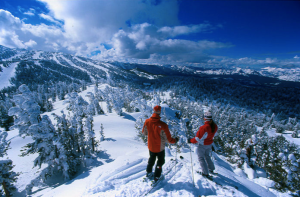Is skiing less dangerous than we may think? With the winter sport more popular than ever, there is a downward trend in injuries. What are the reasons? Why do injuries still occur?
 Martin Burtscher and Gerhard Reudl, two leading professors in the field, share their thoughts on the striking downward trend in injuries associated with alpine skiing in a CMAJ Blog. They state “Assuming a death rate of 1 per 1 million skier days and an injury rate of 1-2 per 1,000 skier days a total of 400 fatalities and 400,000 to 800,000 injured skiers would result. That may be enough to fill newspapers daily but they actually represent a relatively low death and injury risk… Put another way, for the individual who skis for 20 days per winter season on average, 1 death would occur within 50,000 years and 1 injury within 25 to 50 years.”
Martin Burtscher and Gerhard Reudl, two leading professors in the field, share their thoughts on the striking downward trend in injuries associated with alpine skiing in a CMAJ Blog. They state “Assuming a death rate of 1 per 1 million skier days and an injury rate of 1-2 per 1,000 skier days a total of 400 fatalities and 400,000 to 800,000 injured skiers would result. That may be enough to fill newspapers daily but they actually represent a relatively low death and injury risk… Put another way, for the individual who skis for 20 days per winter season on average, 1 death would occur within 50,000 years and 1 injury within 25 to 50 years.”
Still, injuries do happen. We highlight some key findings from BJSM research below.
Who is more likely to be a risk taker?
Risk taking behavior is associated with younger ages, higher skiing ability, male sex, lower body mass index and those with a higher than average speed. Read more in the BJSM Original article on Factors associated with self-reported risk-taking behaviour on ski slopes.
Snowboarders injuries when listening to music are less frequent but more severe. 2014 Original Article in BJSM: Listening to a personal music player is associated with fewer but more serious injuries among snowboarders in a terrain park: a case-control study.
Skiing safely
Although head injuries account for 9–19% of all winter sport injuries reported by ski patrols and emergency departments, the use of ski helmets has been shown to reduce the head injury risk up to 60% among children and adults. Learn more on the successes and challenges of helmet-use uptake in this BJSM Editorial: Is ski helmet legislation more effective than education?
Taken together, the evidence suggests that a fear of serious injury should not prevent you from being active on the slopes, and skiing is safer than ever before. Still, some basic safety precautions may help you experience none of the hazards and all of the health benefits associated with skiing.